
By Tiana Hall
Governor's Intern
Chapter Five
Other Movements During the Time
Prohibition
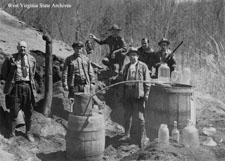
Capturing a still.
Robert R. Keller Collection

Old Company B posing with moonshine stills at courthouse in Williamson, 1921 or 1922.
West Virginia State Police Collection
|
In 1913, West Virginia passed the prohibition law, which made illegal the manufacturing, storage, transportation, or sale of alcohol and alcoholic beverages including wine, beer, and liquor. The only exceptions were "pure grain alcohol for medicinal, pharmaceutical, scientific and mechanical purposes and wine for sacramental purposes by religious bodies."1 The prohibition law went into effect a year later and shut down all bars, known as saloons. In Charleston alone, 32 saloons were shut down.2 Additionally, the prohibition law made an effort to prevent the private consumption and production of alcohol by allowing police officers to raid houses. If alcohol was found inside someone's house, they were jailed, as it was considered a misdemeanor offense and sometimes even a felony.3 The driving force behind the successful passage of the prohibition law was the Women's Christian Temperance Union (WCTU), which was formed in 1874 to oppose the manufacture, sale, and consumption of alcohol. The women of the WCTU believed that alcohol endangered the sanctity of the American family and was responsible for societal ills. Therefore, the WCTU had a moral duty to protect their families and communities from the evils of alcohol. A national prohibition amendment to the U.S. Constitution was passed in 1919. Although the temperance movement was successful, the manufacture and sale of alcohol continued and underground bootlegging flourished in West Virginia, with the massive increase in moonshine production.4 Prior to the prohibition law, moonshine, also known as Mountain whiskey, was widely produced in West Virginia, and got its name because it was illegal and was produced under moonlight.5 In 1933, Prohibition was nationally repealed due to the violence and corruption caused by the illegal liquor. Some West Virginia towns and counties remained dry for many years.6
|
Women's Suffrage
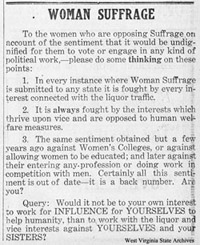
Pro-suffrage notice, 1916
|
Women's Suffrage or the right to vote was a hotly debated national issue, since the Seneca Falls Convention in 1848 . In West Virginia, the suffrage movement started in 1895 with the formation of the West Virginia Equal Suffrage Association (WVESA), which combined nine smaller clubs into a statewide organization. Unfortunately, seven of the nine clubs were dissolved within the first year. Other women's groups also played an active role in campaigning for a woman's right to vote. The Women's Christian Temperance Union (WCTU) sought to prohibit the sale and consumption of alcohol, but they also advocated for women's voting rights. The WCTU women considered alcohol to be the source of many domestic problems and they believed that by having the right to vote women would elect more virtuous public officials who wanted to ban the sale of alcohol. In 1915, suffragists pressured the West Virginia Legislature into casting votes for suffrage amendment. Although the suffragists' efforts failed when the legislature, composed entirely of men, rejected the proposed amendment to the state constitution in November 1916. During the World War I years of 1917 and 1918, many suffragists wholeheartedly supported the war effort in order to demonstrate proof of their patriotism and right to equal treatment.
|
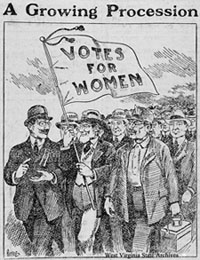
Pro-suffrage cartoon, 1916
|
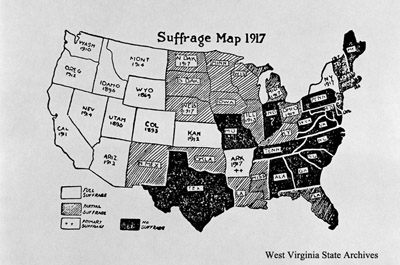
Map of the United States showing the status
of Woman's Suffrage in the states, 1917
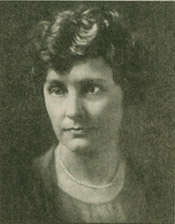
Lenna Lowe Yost
|
After the war ended, Congress approved the Federal Suffrage Amendment, also known as the Susan B. Anthony Amendment, on June 4, 1919. The West Virginia Legislature met in special session in February 1920, and were lobbied heavily by the state's suffragists, led by Lenna Lowe Yost.7 Yost, a native of Marion County, was the president of the WVESA and a member of the WCTU.8 On March 3, the West Virginia House of Delegates voted for the amendment, 47-40. However, the West Virginia State Senate was deadlocked and had a 14-14 tie. Thus, Senator Jesse Bloch was called upon to break the tie. Bloch was vacationing in San Francisco, California, and traveled 3,000 miles by plane and train to cast his vote. Bloch voted in favor of suffrage on March 10, 1920, making West Virginia the 34th of the 36 states needed to ratify the amendment. The states ratified it on August 18, 1920, and the 19th Amendment, guaranteeing all women the right to vote, was added to the U.S. Constitution.9 |

Jesse Bloch
|
|
"All this tommy rot about the women neglecting their housework, babies and husbands if they get the vote is nonsense. Election day comes but once a year and if it will add to their peace of mind and help the United States, I'm willing to do my bit." - Jesse Bloch, quoted in Wheeling News-Register, August 20, 1995 |
The Mine Wars
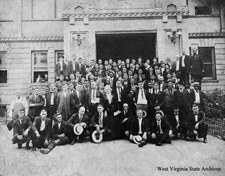
Mother Jones, Bill Blizzard and others on the
steps of the Mingo County courthouse, circa 1915. Marcelene Jude MacClellan Collection
|
Since the inception of the coal industry in West Virginia, coal operators have exploited miners, deprived them of their constitutional rights, and disregarded safety conditions, causing many miners deaths. In the 1890s, an organization that represented the miners interest, known as the United Mine Workers Association (UMWA), was created to help miners negotiate for better wages, hours, and working conditions. The refusal to recognize the UMWA and miners' rights led to the Paint Creek and Cabin Creek Strike in 1912, which started the Mine Wars.10 In 1917, the U.S. entered World War I and the Mine Wars were directly impacted, as there were fewer clashes amongst the UMWA and the coal operators. Coal was a vital resource to the war effort and the state and federal governments suppressed strike actions.11 After the war was over and both the miners and coal operators returned to peacetime civilian life, labor unrest began to erupt with a series of complicated events.12
|
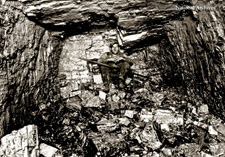
Miner sitting at his place underground.
National Archives
|
The foreign war in Europe and the domestic wars in West Virginia were intertwined. President Woodrow Wilson made a draft exemption for the miners during World War I. Therefore, miners obeyed the coal operators wishes without complaint, as it was a part of their patriotic duty to their country to mine coal. Coal operators used wartime ideology to urge miners to produce more coal through propaganda, parades, and speeches.13 Furthermore, if coal operators felt their workers weren't producing enough coal, they were put on a slacker list, fired, and taken to the draft station, which was a part of their "Work or Fight Campaign." Those who produced the most coal were given bonuses, "honor medals," and placed on the "honor roll." As a result of increased production, coal companies reaped huge profits.14
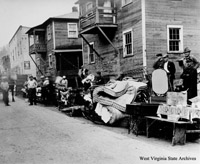
Eviction scene in a mining town.
Coal Life Collection
|
Not only did coal operators use scare tactics to make bigger profits during World War I, they also took actions to keep out the union with the help of the state government and the U.S. Supreme Court. Coal operators prohibited miners from holding public meetings and had mine guards, known as the Baldwin-Felts detectives, attack and beat UMWA organizers. Miners who joined the UMWA were evicted from company housing. In addition, coal operators complained to Governor John Cornwell that members of the UMWA were "treasonable," "anarchists," and impeded their ability to freely produce coal. Cornwell responded to the coal operators by authorizing a bill to call deputy sheriffs to suppress all strikes and require all "able-bodied" men between the ages 16 and 60 to work 30 hours a week or be fined $100.15 Yellow dog contracts in which miners promised to never join the union while employed by a coal company were legalized by the 1917 U.S. Supreme Court decision in Hitchman Coke & Coal Company v. Mitchell.16
|
|
Although World War I was used by the coal companies to oppress their workers and make a bigger profit, it was also used by the miners to insist on their constitutional rights. The public viewed miners as providing for their democracy, which represents freedom and liberty. Miners identified with the soldiers fighting for freedom, because the miners were fighting to be released from the grips of their employers. Many miners realized that the coal companies had profited greatly from the war and wished to win a share of the economic benefit for themselves and their families.17 Moreover, the miners became more vocal after the war about the treatment they had endured. On September 4, 1919, miners began a march for Logan County in reaction to abuses of the Logan Coal Operators Association. This was followed by a strike in Mingo County, 1920-1921, and the Matewan Massacre in May of 1920, which resulted in the murder of Matewan chief of police and UMWA supporter Sid Hatfield on August 1, 1921. The Mine Wars ended in 1922 with the Battle of Blair Mountain, as armed miners marched towards Logan in an attempt to get better wages and working conditions, but the march was put down by the intervention of federal troops.18 "It was seen as the greatest armed insurrection since the Civil War."19
|

Federal troops at Blair Mountain,
September 21, 1921. Coal Life Collection
|
Citations
1. "Prohibition: Acts of the Legislature of West Virginia, Thirty-first Regular Session, 1913. (House Bill No. 8.)," West Virginia Archives and History. Web, http://www.wvculture.org/history/government/prohibition01.html. Accessed 6 June 2017.
2. "Tolling Bells Mark Exit of Liquor Era Prohibition Will Envelop State at 12 O'clock Tonight. Goodbyes Are Said." Charleston Daily Mail June 30, 1914, "Prohibition," West Virginia Archives and History. Web, http://www.wvculture.org/history/government/prohibition02.html. Accessed June 6, 2017.
3. "Prohibition: Acts of the Legislature of West Virginia."
4. "April 20, 1885: Incorporation of the Women's Christian Temperance Union," West Virginia Archives and History. Web, http://www.wvculture.org/history/timetrl/ttapr.html#0420. Accessed 6 June 2017.
5. Sohn, Mark F. "Moonshine." West Virginia Encyclopedia, 2010. Web, http://www.wvencyclopedia.org/articles/2030. Accessed 6 June 2017.
6. "Incorporation of the Women's Christian Temperance Union."
7. "West Virginia's Suffrage Movement." West Virginia Archives and History. Web, http://www.wvculture.org/history/archives/women/suffrage.html. Accessed 19 June 2017.
8. Effland, Anne Wallace. "A Profile of Political Activists: Women of the West Virginia Woman Suffrage Movement." West Virginia History, Volume 49 (1990): 103-14, West Virginia Archives and History. Web, http://www.wvculture.org/history/journal_wvh/wvh49-8.html. Accessed 19 June 2017.
9. Miller, Dawn. "Senator traveled 3000, miles for suffrage vote." Charleston Gazette-Mail, May 9, 1999. Women's Suffrage Clippings, West Virginia Archives and History.
10. "West Virginia's Mine Wars." West Virginia Archives and History. Web, http://www.wvculture.org/history/minewars.html. Accessed 22 June 2017.
11. Corbin, David C. "A War for Democracy," in Life, Work, and Rebellion in the Coal Fields: The Southern West Virginia Miner, 1880-1922, 2nd Edition (Morgantown, WV: West Virginia University Press, 2015). Print. 177-178.
12. "West Virginia's Mine Wars."
13. Corbin, 177-79.
14. Corbin, 186.
15. Corbin, 186-187.
16. "Hitchman Coal & Coke Co. v. Mitchell 245 U.S. 229 (1917)." Justia US Supreme Court. Web. https://supreme.justia.com/cases/federal/us/245/229/. Accessed 26 July 2017.
17. Corbin, 176-177.
18. "West Virginia's Mine Wars."
19. Even the Heavens Weep. Dir. Danny L. McGuire. Prod. Beth Nogay. By Lou Buttino. West Virginia Public Broadcasting-TV, 1985. Documentary.
|



